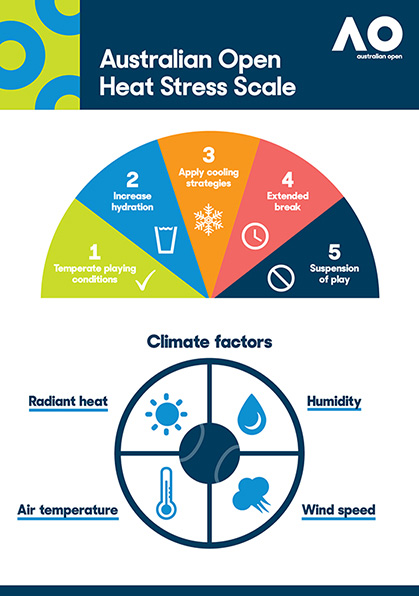A more extensive extreme heat policy is set to be introduced at Australian Open 2019.
Key features include the introduction of a five-point AO Heat Stress Scale as well as more comprehensive measuring of weather conditions at Melbourne Park and an increase in measuring devices across the site.
A 10-minute break during men’s singles singles matches will be introduced after the third set should the heat stress scale hit a level of four.
This break joins the existing 10-minute breaks already in place for women’s singles and junior singles, and the 15-minute break for wheelchair singles matches.
NEWS: tiebreaks to decide final sets at Australian Open
The tournament’s revamped policy comes as a result of cutting-edge research and testing into the specific effects of heat stress on tennis players.
The research was conducted by Tennis Australia medical personnel in conjunction with the Thermal Ergonomics Laboratory at the University of Sydney.
Australian Open Tournament Director Craig Tiley said his team was constantly looking for ways to improve the conditions for the players.
“The wellbeing of all players at the Australian Open is our utmost priority and we have developed the Australian Open Heat Stress Scale after months of research and testing,” he said.
“The AO Heat Stress Scale ranges from one to five with specific recommendations associated with each step of the scale – one denoting temperate playing conditions and five the suspension of play.
“Under the updated policy, 10-minute breaks can also be introduced into men’s singles matches for the first time.”
Tennis Australia Chief Medical Officer Dr Carolyn Broderick said the AO Heat Stress Scale took advantage of the latest medical research into the effects of heat on the human body.
“(This includes) the maximum heat stress an athlete can safely withstand, the sweat rate of that person and their core temperature,” she explained.
“The scale also accounts for the physiological variances between adults, wheelchair and junior athletes while also taking into account the four climate factors – air temperature, radiant heat or the strength of the sun, humidity and wind speed – which affect a player’s ability to disperse heat from their body.
The increase in measuring capabilities at the event will provide more information for organisers than the previous Wet Bulb Globe Temperature (WGBT) readings from the Bureau of Meteorology.
When a four (4.0) is recorded on the AO heat stress scale prior to or during the first two sets of a match, the tournament referee will:
If a five (5.0) is recorded:

16 February 2017
In the first part of our series analysing the similarities and differences between men's ... More
19 February 2016
Roberta Vinci appeared on Italian TV and was put to the test - were the grunts she was hea... More
17 August 2017
Alicia Molik, a former top 10 star who owned one of the sport’s best serves, believes se... More
9 January 2018
As the first Grand Slam of the season fast approaches, top-10 players are leading the char... More